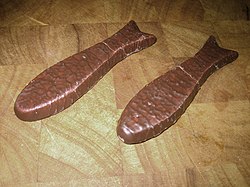Chocolate fish: Difference between revisions
Smithpie1971 (talk | contribs) mNo edit summary |
Smithpie1971 (talk | contribs) mNo edit summary |
||
| Line 23: | Line 23: | ||
Chocolate fish have a conventional [[fish]]-shape and a length of 5 to 8 centimetres. They can be made of pink or white [[marshmallow]] covered in a thin layer of milk [[chocolate]] with the ripples or (scales) on the fish created simply by the fish moving under a blower; this slides the unset chocolate back, creating the illusion of scales on the fish or as a solid milk chocolate variation. Several manufacturers make the fish, but the most well-recognised is [[Cadbury]].{{cn|date=October 2015}} Smaller, or "fun-sized" variants of the chocolate fish are colloquially referred to as "[[sprats]]". For a short period, in the late 1990s - early 2000, there was a [[Tip Top (icecream)|Tip Top]] brand chocolate fish ice-cream.<ref>[http://www.stuff.co.nz/life-style/food-wine/3776709/Marshmallow-ice-cream-conquered "Marshmallow ice-cream conquered"], 04/06/2010, stuff.co.nz </ref> |
Chocolate fish have a conventional [[fish]]-shape and a length of 5 to 8 centimetres. They can be made of pink or white [[marshmallow]] covered in a thin layer of milk [[chocolate]] with the ripples or (scales) on the fish created simply by the fish moving under a blower; this slides the unset chocolate back, creating the illusion of scales on the fish or as a solid milk chocolate variation. Several manufacturers make the fish, but the most well-recognised is [[Cadbury]].{{cn|date=October 2015}} Smaller, or "fun-sized" variants of the chocolate fish are colloquially referred to as "[[sprats]]". For a short period, in the late 1990s - early 2000, there was a [[Tip Top (icecream)|Tip Top]] brand chocolate fish ice-cream.<ref>[http://www.stuff.co.nz/life-style/food-wine/3776709/Marshmallow-ice-cream-conquered "Marshmallow ice-cream conquered"], 04/06/2010, stuff.co.nz </ref> |
||
In 2016, the Chocolate Fish Company (NZ) conceptualised a new Zealand native 'Kokopu' (giant native trout) in solid milk chocolate to add to Kiwi's choice of Chocolate Fish confectionary. It is now commercially available and |
In 2016, the Chocolate Fish Company (NZ) conceptualised a new Zealand native 'Kokopu' (giant native trout) in solid milk chocolate to add to Kiwi's choice of Chocolate Fish confectionary. It is now commercially available and the company has committed to donate part of any profits to cleaning up the waterways that make up the Kokopu's natural habitat. |
||
==References== |
==References== |
||
{{reflist}} |
{{reflist}} |
||
Revision as of 08:39, 3 July 2017
 Two chocolate fish by side | |
| Type | Confectionery |
|---|---|
| Place of origin | New Zealand |
| Main ingredients | Pink or white marshmallow, milk chocolate |
In New Zealand, the chocolate fish is a popular confectionery item, and in Kiwi culture a common reward for a job done well ("Give that kid a chocolate fish").[1][2][3][4][5]
Chocolate fish have a conventional fish-shape and a length of 5 to 8 centimetres. They can be made of pink or white marshmallow covered in a thin layer of milk chocolate with the ripples or (scales) on the fish created simply by the fish moving under a blower; this slides the unset chocolate back, creating the illusion of scales on the fish or as a solid milk chocolate variation. Several manufacturers make the fish, but the most well-recognised is Cadbury.[citation needed] Smaller, or "fun-sized" variants of the chocolate fish are colloquially referred to as "sprats". For a short period, in the late 1990s - early 2000, there was a Tip Top brand chocolate fish ice-cream.[6]
In 2016, the Chocolate Fish Company (NZ) conceptualised a new Zealand native 'Kokopu' (giant native trout) in solid milk chocolate to add to Kiwi's choice of Chocolate Fish confectionary. It is now commercially available and the company has committed to donate part of any profits to cleaning up the waterways that make up the Kokopu's natural habitat.
References
- ^ "...each presented with a large chocolate fish", 1933, Evening Post
- ^ "I'll Buy You A Chocolate Fish If...", 1973
- ^ "The food we love – the tastes of New Zealanders"
- ^ "...for many years a brand of chocolate fish was known as “Pelorus Jack”.", 1966, A Encyclopaedia of New Zealand
- ^ "...Sir Geoffrey Palmer offered the audience a chocolate fish for anyone who could define privacy.", Privacy Commissioner
- ^ "Marshmallow ice-cream conquered", 04/06/2010, stuff.co.nz
